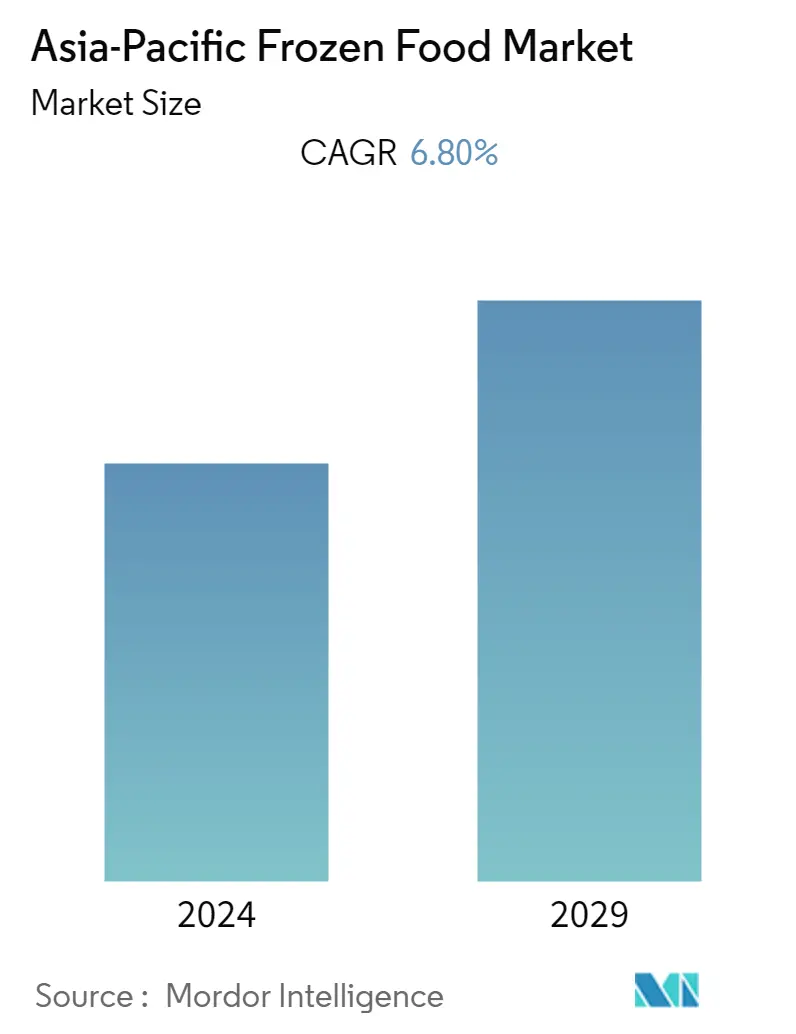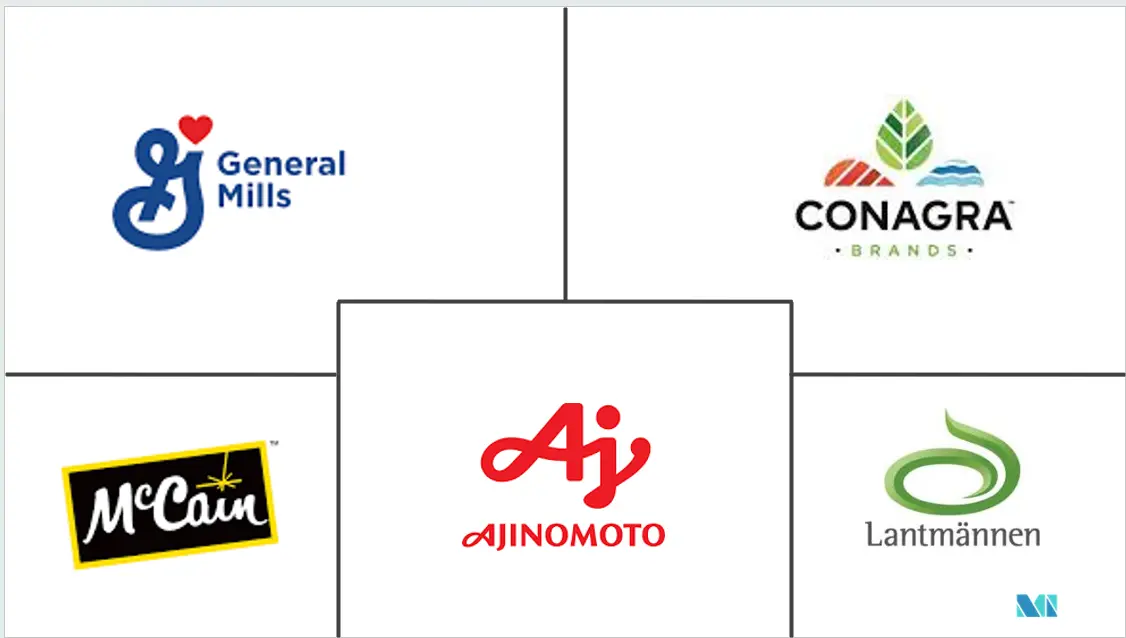Market Size of Asia-Pacific Frozen Food Industry

| Study Period | 2019 - 2029 |
| Base Year For Estimation | 2023 |
| Forecast Data Period | 2024 - 2029 |
| Historical Data Period | 2019 - 2022 |
| CAGR | 6.80 % |
| Market Concentration | Medium |
Major Players
*Disclaimer: Major Players sorted in no particular order |
APAC Frozen Food Market Analysis
Asia-Pacific Frozen Food Market is projected to register a CAGR of 6.8% during the forecast period, 2022-2027.
The market is majorly driven by the growing consumer interest in shelf-stable food due to hectic lifestyles. Expanding working women population accompanied by economic development has fueled the demand for convenience food such as frozen food in the region over the past decade. Over the years, the market evolved from selling raw foods, such as frozen meat, fish, vegetables, and fruits, to prepared ready meals, ready-to-cook food such as dough, cutlets, gravy mixes, sandwiches, etc., and frozen desserts.
Convenience is the key factor influencing consumer preference as ready-to-cook frozen foods need less preparation time. Moreover, rising technological innovations including freezing technologies and a cold chain supply chain enable easy accessibility of frozen food products across the region, which in turn supports the market expansion. Further, the advent of new technologies has resulted in the affordability of frozen food. However, factors like the change in the flavors, including sweetness, fat content, and texture when compared to fresh foods are expected to affect the market's growth.
APAC Frozen Food Industry Segmentation
Frozen food is defined as food products that are preserved under low temperatures and used over a long period. The scope of the market refers to the packaged frozen food marketed at retail outlets only. The frozen food market is segmented by product type, product category, distribution channel, and geography. By product type, the market is segmented into frozen fruits and vegetables, frozen snacks, frozen seafood, frozen meat and poultry, frozen desserts, and other product types. By product category, the market is classified as ready-to-eat, ready-to-cook, and others. By distribution channel, the market is segmented into supermarkets/hypermarkets, convenience stores, online retail channels, and other distribution channels. By geography, the market is segmented into China, Japan, India, Australia, and the Rest of Asia-Pacific. For each segment, the market sizing and forecasts have been done on the basis of value (in USD million).
| By Product Type | |
| Frozen Fruits & Vegetables | |
| Frozen Snacks | |
| Frozen Seafood | |
| Frozen Meat and Poultry | |
| Frozen Desserts | |
| Other Types |
| By Product Category | |
| Ready-to-eat | |
| Ready-to-cook | |
| Others |
| By Distibution Channel | |
| Supermarkets and Hypermarkets | |
| Convenience Stores | |
| Online Retail Channels | |
| Other Distribution Channels |
| By Geography | |
| China | |
| Japan | |
| India | |
| Australia | |
| Rest of Asia-Pacific |
Asia-Pacific Frozen Food Market Size Summary
The Asia-Pacific frozen food market is experiencing significant growth, driven by the increasing consumer demand for convenience foods due to busy lifestyles. The market has evolved from offering basic frozen items like meat and vegetables to a wide range of prepared meals and desserts, catering to the need for quick and easy meal solutions. Technological advancements in freezing and cold chain logistics have enhanced the accessibility and affordability of frozen foods, further propelling market expansion. Despite some challenges related to taste and texture differences compared to fresh foods, the demand for ready-to-cook and instant meal options remains strong, particularly among millennials who favor products that require minimal preparation.
The market is characterized by a moderate level of competition, with both global and regional players actively participating. Key companies such as McCain Foods, Ajinomoto, and General Mills are leveraging advanced distribution networks and innovative product offerings to maintain a competitive edge. The rise of e-commerce has also transformed the retail landscape, with brands partnering with online platforms to reach a broader audience. This shift is evident in the introduction of new frozen food lines and packaging solutions that emphasize convenience and sustainability. Additionally, the market is witnessing a growing interest in plant-based frozen foods, with companies like Continental Coffee and Tyson Foods expanding their offerings to cater to health-conscious consumers.
Asia-Pacific Frozen Food Market Size - Table of Contents
-
1. MARKET DYNAMICS
-
1.1 Market Drivers
-
1.2 Market Restraints
-
1.3 Porter's Five Force Analysis
-
1.3.1 Threat of New Entrants
-
1.3.2 Bargaining Power of Buyers/Consumers
-
1.3.3 Bargaining Power of Suppliers
-
1.3.4 Threat of Substitute Products
-
1.3.5 Intensity of Competitive Rivalry
-
-
-
2. MARKET SEGMENTATION
-
2.1 By Product Type
-
2.1.1 Frozen Fruits & Vegetables
-
2.1.2 Frozen Snacks
-
2.1.3 Frozen Seafood
-
2.1.4 Frozen Meat and Poultry
-
2.1.5 Frozen Desserts
-
2.1.6 Other Types
-
-
2.2 By Product Category
-
2.2.1 Ready-to-eat
-
2.2.2 Ready-to-cook
-
2.2.3 Others
-
-
2.3 By Distibution Channel
-
2.3.1 Supermarkets and Hypermarkets
-
2.3.2 Convenience Stores
-
2.3.3 Online Retail Channels
-
2.3.4 Other Distribution Channels
-
-
2.4 By Geography
-
2.4.1 China
-
2.4.2 Japan
-
2.4.3 India
-
2.4.4 Australia
-
2.4.5 Rest of Asia-Pacific
-
-
Asia-Pacific Frozen Food Market Size FAQs
What is the current Asia-Pacific Frozen Food Market size?
The Asia-Pacific Frozen Food Market is projected to register a CAGR of 6.80% during the forecast period (2024-2029)
Who are the key players in Asia-Pacific Frozen Food Market?
McCain Foods Limited, Ajinomoto Co. Inc., General Mills, Inc., Conagra Brands Inc. and Lantmannen are the major companies operating in the Asia-Pacific Frozen Food Market.

